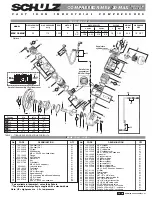
Section 7
MAINTENANCE
35
1. Relieve all pressure from the sump tank and all
compressor lines.
2. Disconnect all piping connected to the sump cov-
er to allow removal (return lines, service lines,
etc.).
3. Loosen and remove the eight (8) hex head caps-
crews (1/2---13 x 1 1/2”) from the cover plate.
4. Lift the cover plate from the sump.
5. Remove the separator element.
6. Inspect the receiver/sump tank for rust, dirt, etc.
7. Scrape the old gasket material from the cover
and flange on the sump. Be careful not to let the
scraps fall in the sump.
8. Reinsert the separator element into the sump tak-
ing care not to dent the element against the tank
opening.
9. Clean the underside of the receiver/sump tank
cover and remove any rust.
10. Replace the cover plate, washers and caps-
crews. Torque to 55 ft---lbs. (75 Nm).
11. Reconnect all piping making sure return line
tubes extend to the bottom or 1/4” (6mm) above
the bottom of the separator element. This will as-
sure proper fluid return flow to the compressor.
12. Clean the return line strainers before restarting
the compressor.
CONTROL SYSTEM ADJUSTMENT
Refer to Figure 7---4. Prior to adjusting the Control
System, it is necessary to determine the desired op-
erating pressure range and also the maximum pres-
sure at which your compressor is to operate. The
pressure must not exceed the maximum operating
pressure which is stamped on the compressor seri-
al number nameplate. The following explanation ap-
plies to a typical installation with a desired operating
range of 115 to 125 psig (7.9 to 8.6 bar). This infor-
mation will apply to a compressor with any other op-
erating range excepting the stated pressures.
Remove the cover of the pressure switch. With the
shut---off valve closed (or slightly cracked open)
start the compressor. Observe the line pressure
gauge and pressure switch contacts. When the line
pressure reaches 125 psig (8.6 bar), the pressure
switch contacts should open. If the pressure switch
contacts do not open or they open prior to the de-
sired pressure, the pressure switch setting will re-
quire adjustment (refer to Figure 7---4).
FOR PRESSURE RANGE ADJUSTMENT
:
1. Remove cover to pressure switch.
2. Turn the range adjusting screw to the high pres-
sure setting. Turning the screw counterclockwise
lowers both the high and low pressure equally.
FOR DIFFERENTIAL ADJUSTMENT:
Differential is the difference between the high and
low pressure settings. 10 psig (0.7 bar) is typical.
1. Turn the differential adjusting screw to the lower
(reset) setting. Turning the screw counterclock-
wise widens the differential by lowering the reset
(lower) setting only.
2. When the pressure switch adjustment is com-
plete, the pressure regulator should be adjusted
for the pressure at which modulation of air deliv-
ery should begin. In this case that pressure will
be 118 psig (8.2 bar). The regulator is adjusted
by loosening the jam nut on the end of the cone
shaped cover of the pressure regulator. When
the jam nut is loose, turn the adjusting screw
clockwise to increase or counterclockwise to de-
crease the setting.
3. To set the regulator, continue closing the service
valve until the line pressure is 118 psig (8.2 bar).
At this point regulator should pass a signal to the
inlet valve to start closing it. If the line pressure
keeps on rising or if the modulation does not be-
gin, adjust the regulator valve as described
above. After adjustment, line pressure should be
approximately 118 psig (8.2 bar) and 1.00 in. Hg
(2.54 cm Hg.) vacuum below the inlet.
4. Next, close the service valve; line pressure will
start rising. When line pressure reaches 125 psig
(8.6 bar), the inlet valve will be closed to its maxi-
mum position. The inlet vacuum at this point will
be around 25 in. Hg (63.5 cm Hg.). The machine
should unload at this point.
Figure 7---4 Pressure Switch
P/N 040694--- Standard
P/N 407778--- High Pressure
Summary of Contents for LS-10 18KW 24KT
Page 6: ...NOTES...
Page 15: ...Section 2 DESCRIPTION 9 Figure 2 3 Control System...
Page 18: ...12 NOTES...
Page 22: ...16 NOTES...
Page 26: ...20 NOTES...
Page 34: ...28 NOTES...
Page 38: ...32 NOTES...
Page 48: ...Section 7 MAINTENANCE 42 Figure 7 7 Piping and Instrumentation Diagram Standard...
Page 49: ...Section 7 MAINTENANCE 43 Figure 7 8 Piping and Instrumentation Diagram Supervisor II...
Page 50: ...44 NOTES...
Page 52: ...Section 8 ILLUSTRATIONS AND PARTS LIST 46 8 3 MOTOR COMPRESSOR FRAME AND PARTS...
Page 54: ...Section 8 ILLUSTRATIONS AND PARTS LIST 48 8 3 MOTOR COMPRESSOR FRAME AND PARTS...
Page 56: ...Section 8 ILLUSTRATIONS AND PARTS LIST 50 8 4 COOLER ASSEMBLY...
Page 58: ...Section 8 ILLUSTRATIONS AND PARTS LIST 52 8 5 AIR INLET SYSTEM...
Page 60: ...Section 8 ILLUSTRATIONS AND PARTS LIST 54 8 6 COOLING AND LUBRICATION SYSTEM...
Page 62: ...Section 8 ILLUSTRATIONS AND PARTS LIST 56 8 6 COOLING AND LUBRICATION SYSTEM...
Page 68: ...Section 8 ILLUSTRATIONS AND PARTS LIST 62 8 8 CONTROL SYSTEM AND ELECTRICAL PARTS...
Page 70: ...Section 8 ILLUSTRATIONS AND PARTS LIST 64 8 8 CONTROL SYSTEM AND ELECTRICAL PARTS...
Page 72: ...Section 8 ILLUSTRATIONS AND PARTS LIST 66 8 9 INSTRUMENT PANEL...
Page 76: ...Section 8 ILLUSTRATIONS AND PARTS LIST 70 8 11 DECAL GROUP 1 2 3 4 5 6 7 8 9 10 11...
Page 78: ...Section 8 ILLUSTRATIONS AND PARTS LIST 72 8 11 DECAL GROUP 12 13 14 15 16 17 18 19 20...
Page 80: ...Section 8 ILLUSTRATIONS AND PARTS LIST 74 8 11 DECAL GROUP 21 22 23 24 25 26 27...
Page 82: ...Section 8 ILLUSTRATIONS AND PARTS LIST 76 8 11 DECAL GROUP ADD FULL 29 28 30 31...
Page 88: ...NOTES...
Page 89: ...NOTES...
















































